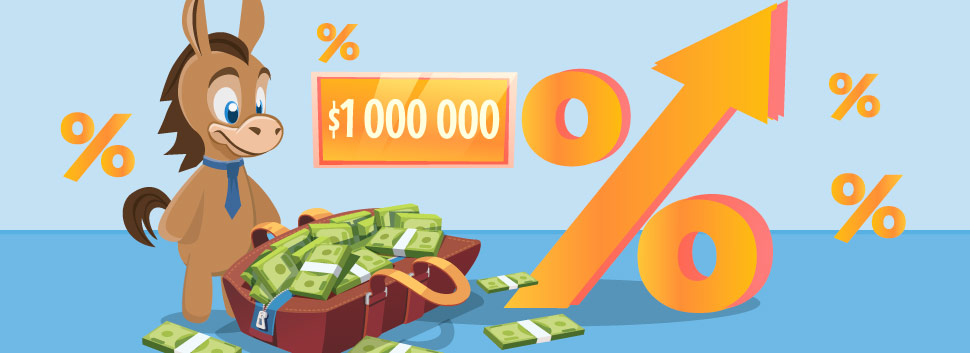How Much Interest Will I Make On A Million Dollars

For many, the thought of having a million dollars conjures up images of financial freedom and security. But how much actual income can a million dollars generate in today's economic climate? The answer, unsurprisingly, is complex and depends heavily on investment choices and prevailing interest rates.
Understanding the potential interest earnings on a substantial sum like a million dollars is crucial for financial planning, retirement strategies, and assessing the viability of various investment options. This article explores the range of possible interest income, considering factors like savings accounts, bonds, and dividend-paying stocks, offering a balanced perspective on maximizing returns while managing risk.
Savings Accounts: A Safe But Modest Return
Savings accounts are generally considered one of the safest places to park money, but they typically offer the lowest interest rates. According to data from the Federal Deposit Insurance Corporation (FDIC), the national average interest rate for savings accounts hovers around a fraction of a percent.
At a rate of 0.50% (a figure that can fluctuate), a million dollars would generate a meager $5,000 in interest annually. While safe, this return barely keeps pace with inflation, meaning the real purchasing power of the investment could erode over time.
High-Yield Savings Accounts
Some online banks and credit unions offer high-yield savings accounts with more competitive interest rates. These accounts might offer rates in the range of 4% to 5% Annual Percentage Yield (APY).
Earning a 4% APY on a million dollars would generate $40,000 per year. While significantly better than the national average, these rates are still subject to change based on broader economic conditions and the Federal Reserve's monetary policy.
Bonds: Balancing Risk and Return
Bonds represent a slightly higher risk and potentially higher reward compared to savings accounts. Government bonds, like U.S. Treasury bonds, are generally considered low-risk, while corporate bonds carry a higher degree of risk depending on the issuer's creditworthiness.
The yield on a bond varies based on factors like its maturity date, credit rating, and current interest rate environment. A million dollars invested in a mix of government and high-quality corporate bonds might yield an average of 3% to 6% annually, generating $30,000 to $60,000 in interest income.
It is important to note that bond prices and yields have an inverse relationship, meaning that as interest rates rise, bond prices tend to fall, potentially impacting the overall value of the investment.
Dividend-Paying Stocks: Potential for Growth and Income
Investing in dividend-paying stocks offers the potential for both capital appreciation and dividend income. Dividend yields, representing the annual dividend payment as a percentage of the stock price, can vary widely across different companies and sectors.
A well-diversified portfolio of dividend-paying stocks might yield an average of 2% to 4%. This would generate $20,000 to $40,000 in dividend income on a million-dollar investment, before considering any potential capital gains or losses.
However, stock investments carry a higher degree of risk compared to savings accounts or bonds, as stock prices can fluctuate significantly due to market volatility and company-specific factors. Moreover, dividends are not guaranteed and can be reduced or eliminated by the company.
The Impact of Taxes and Inflation
The interest income earned from savings accounts, bonds, and dividend-paying stocks is typically subject to federal and state income taxes. These taxes can significantly reduce the net return on investment.
Inflation also erodes the real purchasing power of investment income. If the rate of inflation exceeds the after-tax return on investment, the real value of the principal will decrease over time. Therefore, it's crucial to consider both tax implications and inflation when assessing the potential income from a million-dollar investment.
Seeking Professional Advice
Determining the optimal investment strategy for a million dollars requires careful consideration of individual financial goals, risk tolerance, and time horizon. Consulting with a qualified financial advisor can help individuals develop a personalized investment plan that balances income generation, capital preservation, and growth potential.
Investment decisions should be based on thorough research, professional advice, and a clear understanding of the associated risks. There is no one-size-fits-all solution, and what works for one individual may not be suitable for another.
Ultimately, the amount of interest one can earn on a million dollars is a variable figure dependent on a variety of factors, from risk appetite to market conditions. While achieving a comfortable income stream is possible, it requires careful planning and a realistic understanding of both the opportunities and the potential pitfalls.















![How Much Interest Will I Make On A Million Dollars How to Make a Million Dollars in 2025 [9 Ways to Make $1 Million]](https://www.wallstreetzen.com/blog/wp-content/uploads/2023/06/pexels-john-guccione-wwwadvergroupcom-3531895-scaled.jpg)


